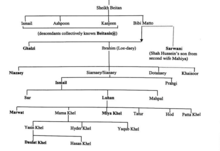Lodi (Pashtun tribe)
| Lodi | |
|---|---|
 The list of Lodi sub-tribes |
Lodi (Pashto; لودهی) is a Pashtun tribe from the Bettani group of Pashtuns.[1][2] In mythical genealogy, they have also been considered as being part of the Bettani tribal confederacy.[3] The Lodi tribe consists of many sub-tribes, most of whom are now settled in the Tank, Frontier Region Tank, Lakki Marwat and Dera Ismail Khan districts of Khyber Pakhtunkhwa province of modern-day Pakistan.[4] These tribes were nomadic for most of their existence and migrated to their present-day locations by crossing the Gomal Pass throughout different times in history.[3]
Two tribes among the Lodi ended up establishing their own empires, the Sur tribe established the Sur Empire[5] and the Prangi tribe established the Lodi Dynasty.[3]


Lohani
[edit]Lohani, also known as Nuhani, is the largest sub-group among the Lodi tribe.[6][7] The Lohani migrated and crossed the Gomal Pass en masse during the late 1500s, into present-day Lodi territory and displaced other Lodi tribes such as Sur and Prangi that had settled in the region in prior times.[8] Although other Lohani tribes had also made earlier deeper incursions into India, as far as Bihar, and settled therein during the days of the Lodi dynasty.[9][10]
Earliest mentions of the Lohani
[edit]The earliest mention of the Lohani tribes comes in the form of an inscription written on a tablet from 1496 AD in Bihar during the days of the Lodi dynasty.[9] The inscription records the construction of a certain gate by Darya Khan Nuhani who is thereafter mentioned as one of the ''governors of the kingdom". The Lohani tribes were also mentioned by the Mughal Emperor Babur in his memoirs, the Baburnama, as Nuhani Afghans around 1529 AD.[10] The earliest records mentions them as Nuhani rather than Lohani, which is the primary designation by which they are currently known today.
References
[edit]- ^ Malik, Jamal (2008). Islam in South Asia: A Short History. p. 123. ISBN 978-9004168596.
- ^ "Ḥayāt-i Afghānī". Library of Congress, Washington, D.C. 20540 USA. p. 268. Retrieved 2022-10-25.
- ^ a b c A Glossary of the Tribes and Castes of the Punjab and North-West Frontier Province. Atlantic Publishers & Dist. 1997. p. 241. ISBN 978-81-85297-68-2.
- ^ "History of the Afghans. | Library of Congress".
- ^ Kissling, H. J.; Spuler, Bertold; Barbour, N.; Trimingham, J. S.; Braun, H.; Hartel, H. (1997-08-01). The Last Great Muslim Empires. BRILL. ISBN 978-90-04-02104-4.
- ^ Office, Punjab Settlement Commissioner's; Tucker, H. St George (1879). Report of the Land Revenue Settlement of the Dera Ismail Khan District of the Punjab, 1872-79. W. Ball. p. 42.
- ^ Rashid, "History of the Pathans", Vol.III, p-367-89, Haroon. History of the Pathans. Vol. III. pp. 367–89.
{{cite book}}: CS1 maint: multiple names: authors list (link) CS1 maint: numeric names: authors list (link) - ^ A Glossary of the Tribes & Castes of the Punjab & North-west Frontier Province: Based on the Census Report for the Punjab, 1883, by the Late Sir Denzil Ibbetson ... & the Census Report for the Punjab, 1892, by Sir Edward Maclagan ... & Comp. by H.A. Rose ... Superintendent, government printing, Punjab. 1914. p. 242.
- ^ a b Siddiqi, Jamal. Epigraphia Indica: Arabic and Persian Supplement (In Continuation of the Series Epigraphia Indo-Moslemica) 1966 and 1967. Archaeological Survey of India, New Delhi. p. 172.
- ^ a b Beveridge, Annette (May 2017). Baburnama: A Memoir (PDF). p. 24. ISBN 978-8129141750.
